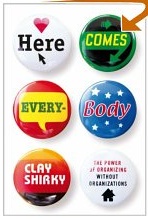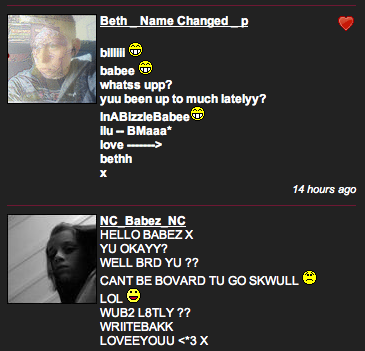Talking in private. In public.
 When we encouraged Youth Workers in Rotherham to explore MySpace and Bebo a few weeks back - many put the names of young people they knew into the search engines and found they were quickly browsing public exchanges of messages on profile walls talking about nights out, social goings on and the latest news from small friendship groups.
When we encouraged Youth Workers in Rotherham to explore MySpace and Bebo a few weeks back - many put the names of young people they knew into the search engines and found they were quickly browsing public exchanges of messages on profile walls talking about nights out, social goings on and the latest news from small friendship groups. In 'Here Comes Everybody: the power of organising without organisations' Clay Shirky explores exactly this phenomena and reflects:
...it's easy to deride this sort of thing as self-absorbed publishing - why would anyone put such drivel out in public?
 And, in the case of professionals concerned with young people's safety, it's easy to react to this sort of sharing as odd, weird and worrying behaviour by young people. But Clay encourages us to at least be critical as we look to understand what is going on.
And, in the case of professionals concerned with young people's safety, it's easy to react to this sort of sharing as odd, weird and worrying behaviour by young people. But Clay encourages us to at least be critical as we look to understand what is going on. It's simple. They're not talking to you.
We misread this seemingly inane posts because we're so unused to seeing written material in public that isn't intended for us. They people posting messages to one another in small groups are doing a different kind of communicating than people posting messages for hundreds of thousands of people to read. More is different, but less is different too. An audience isn't just a big community; it can be more anonymous, with many fewer ties amongst its users. A community isn't just a small audience either; it has a social density that audiences lack. The bloggers and social network users operating in small groups are part of a community, and they are enjoying something analogous to the privacy of the mall. On any given day you could go o the food court in a mall and find a group of teenagers hanging out and talking to one another. They are in public, and you could certainly site at the next table over and listen in on them if you wanted to. And what would they be saying to one another? They'd be saying "I can't believe I missed you last night!!! Trac talked to you and said you were TRASHED off your ASS!" They'd be doing something similar to what they are doing on LiveJournal or Xanga, in other words, if you were listing in on their conversation, rather than reading their post, it would be clear that you were the weird one.
So, what are Youth Workers to do? Well - the difference between the mall and the MySpace profile, is that in the Mall (ok, let's switch to shopping centre and Anglicise this a bit) - in the shopping centre, you have more of a chance of noticing that someone is listening in on your conversation and adapting behaviour accordingly. By default, social network sites don't afford their users the ability to sense or know who is looking at what they share in online conversations.
Helping young people to identify the possible invisible audience for their conversations online... from parents or teachers, other peers, through to anonymous adults - and to change their privacy settings or behaviors to take account of that could form a key part of any youth work sessions with young people that explore social networking.
0 TrackBacks
Listed below are links to blogs that reference this entry: Talking in private. In public..
TrackBack URL for this entry: http://archive.practicalparticipation.co.uk/mt/mt-tb.cgi/35


Leave a comment